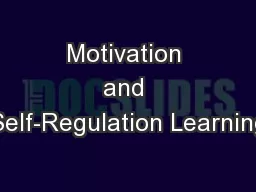PPT-The Motivational Basis of Effective Performance and Well-be
Author : danika-pritchard | Published Date : 2015-10-22
Edward L Deci Motivation Concerns the Energy for Action Its what Moves People to Behave The Traditional View Motivation is unitary The Differentiated View There
Presentation Embed Code
Download Presentation
Download Presentation The PPT/PDF document "The Motivational Basis of Effective Perf..." is the property of its rightful owner. Permission is granted to download and print the materials on this website for personal, non-commercial use only, and to display it on your personal computer provided you do not modify the materials and that you retain all copyright notices contained in the materials. By downloading content from our website, you accept the terms of this agreement.
The Motivational Basis of Effective Performance and Well-be: Transcript
Download Rules Of Document
"The Motivational Basis of Effective Performance and Well-be"The content belongs to its owner. You may download and print it for personal use, without modification, and keep all copyright notices. By downloading, you agree to these terms.
Related Documents














